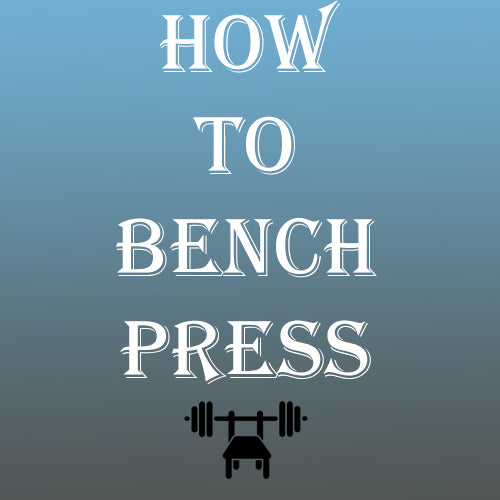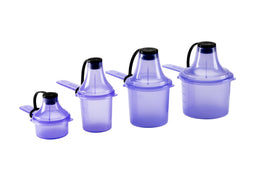How To Bench Press; A Beginner's Bench Pressing Guide

The bench press is one of the most popular exercises there is. Check out any small-to-big transformation movie and it usually begins with a scrawny, hopeful kid staring at an empty and intimidating bench press.
The bench press is a unique lift because it doesn't only work the chest, but also the other push muscles like the shoulders and triceps. Many lifters aren't aware that while getting stronger at the bench press, and having your chest grow because of it, your shoulders and triceps will grow as well.
When Are You Ready To Take On The Bench Press?

The first thing you're going to need to do is make sure that you can get the bar up without any additional weight on it. The usual barbell found in most weight rooms will be close to 45 lbs, so first testing out and getting a feel for that weight will help you gauge weather or not you're ready for the bench press. If you're finding the bar too difficult, then it is recommended that you first start with press ups, and then work your way up to the bench press.
How To Bench Press
Before we talk about improving your form or making adjustments to your movement patterns, we're first going to cover the basics.
- Lie down on a bench (and make sure your back is flat).
- Make sure you grab the bar with your hands slightly wider than shoulder-width apart. You want your hands to be directly above your elbows when the bar touches your chest to allow for maximum strength generation.
- Lower the bar down to your chest as you breathe in.
- Push up and exhale. Make sure you have someone watch you (at first) so you can get learn what it feels like to have the bar travel in the same path each time. Once you can control your bar path at will, you will be able to control which parts of your muscle bear the majority of the burden.
Sadly, it can be fairly easy to tear a shoulder muscle if you begin benching too aggressively without utilizing perfect form. Please take the time necessary to master the fundamental form of the bench press before adding weight that is difficult for you to manage. Learning proper form before you go too heavy will minimize the chances of you injuring yourself in the future.
It is important to note that there are many variations of the bench press. When first starting out, it may be tempting to jump in and try all of the variations out right away. From incline, to decline, to everything in between, the European Journal of Sports Science has stated that muscle stimulation was greatest when someone was benching from a flat position. But variations do have their place. Once you gain some solid experience with the flat bench, and have developed a strong mind-muscle connection, feel free to safely incorporate variations as necessary.
Bench Press Form Tips
Get a grip
Your hands should be gripping the bar about shoulder-width apart. If your grip is too wide, you risk injuring your shoulders. And if your grip is too narrow, you may injure your elbows.
Keep your feet on the floor
When benching, you're going to want to press your feet hard into the floor while flexing your quads. Doing so will allow you to create tension throughout your entire body, allowing your muscles to recruit and fire off fibers most effectively.
Arch your lower back
Maintaining a strong arch in your lower back as you lift the weight off your chest and put it back down is essential in proper bench form. You want to make sure that your glutes stay touching the bench, but that they are flexed enough so that you can use your lower back and abs for leverage, making sure they don't move during the lift. Pulling your shoulders down onto the bench will also create more tension throughout your body, helping you push a little bit harder and lift a little bit more weight during your bench press.
Keep your elbows close
When benching, you want to make sure you keep your elbows as close to your body as possible. The weight should feel like it's being pushed out from the inside out instead of the outside in. Keeping your elbows properly tucked will also ensure that you hit the correct part of the chest.
Be head strong
One of the biggest mistakes beginning benchers make is lfiting their head off of the bench when they lift. Not only will lifting your head off the bench set into motion a chain reaction that will make your body slightly more unstable, but you also risk neck injuries from the sudden movement of the head. Keeping your head resting softly on the bench will be your best bet for avoiding neck injures while benching.
7 Exercises To Build Bench Strength
Once you've mastered correct form on the bench press, you're going to want to take your bench press journey to the next level by strengthening some of the key supporting muscles that work alongside the chest during the bench press. Strengthening these muscles will allow you to lift with more stability and push more weight.
Close-Grip Bench Press

Benching with a narrow grip shifts the emphasis to your triceps while safeguarding your shoulders. It’s a good way to work on weaknesses in your regular bench press, or just get a bit more work in on arms day. Grip the bar with your hands roughly shoulder-width apart, then bring it down to your chest, keeping your elbows tucked in to your sides. Pause, then press it back to the starting position.
Incline Bench Press

Once you've mastered the form of the flat bench, begin working in some incline presses. Bench pressing on an incline shifts the emphasis towards the upper pec as opposed to the lower pec. It is likely that you will not be able to lift as much on the incline bench press as you can during the flat bench press, so adjust your weights accordingly. When the weight comes down, it should touch your chest softly, right above your nipples.
Dumbbell Bench Press

The main function of the pecs in pressing moves is to bring the arms towards the center of your body. While doing a barbell bench press, that "move towards the center of the body" motion gets reduced because of the fact your hands are static. With dumbbells, you'll be able to push the weight up as well as inward to fully activate the pectoral muscles.
TRX Press-up

According to the Journal Of Strength And Conditioning Research, doing press-ups on a suspension trainer increases muscle activation in the chest, shoulder and abs muscles. Start with your feet on the floor, holding the TRX handles. Brace your core and glutes to keep your body in a straight line. Bend your elbows to lower your chest, then press back up to the start.
Doing press ups on a TRX is great for your chest because it recruits all of the chest's stabilizer muscles as well. For a proper TRX press up, start with your feet on the floor and grip the TRX handles. Once you have the handles in your hand, tighten up your body so it stays straight, then do a pushup.
Dumbbell Triceps Extension

In any big lift you’re only ever as strong as your weakest link, and neglecting your triceps can severely hamper your big bench aspirations. Start with light dumbbells and master the full movement range, then increase the weight.
Triceps are big supporters of the bench press, especially during the last few inches of the extension. Begin your tricep extension journey using light weight, slowly increasing as you gain strength and stability.
Dumbbell Flys

The fly is one of the few lifts that truly isolates the chest muscles, and puts all of the lifting force onto them. Doing regular flye exercises will help you build up your mind muscle connection while getting a feel for how different angles affect different parts of the chest.
Common Bench Press Mistakes (Avoid Shoulder Injury)
If you're worried about injuring your shoulders while bench pressing, or have suspicions that bench pressing is currently damaging your shoulders, then keep reading.
One of the most effective ways to prevent injuring your shoulders while performing pushing movements is to simply do more pulling movements. Face pulls and resistance band pulls are especially effective. These exercises will also help your posture straighten up if you feel yourself beginning to hunch from weaker back and overactive chest muscles.
Your elbows are out too wide or in too close.
When benching, you're going to want to make sure that your elbows aren't too wide, but aren't too close either. Keeping your elbows at the proper angle will make a huge difference in your ability to perform the bench press as well as how well you'll be able to activate your chest during the lift. In short, elbows that are too wide can cause straining on the shoulder joint and rotator cuff. And if they are too narrow, your triceps will tend to take over, leaving you with less chest activation and therefore less gains. Usually, people will have more problems flaring their elbows out too much than keeping them too close, so it could be beneficial for you to have someone who knows what they're doing spot your form the first few times you do it.
The barbell is bouncing off your chest.
If you need to bounce the barbell off of your chest, then the weight you're lifting may be too heavy for you. If you can't control the speed of the rep, assuming you're not going for a PR, then you may actually benefit going lighter, because you are using a bunch of different muscles alongside the chest. Springing the bar up too quickly off the middle of your chest can also cause injuries in a variety of places.
You don’t have enough contact with the bench.
It is beneficial to get into the habit of going through a few checkpoints when you first lie down on the bench. You want to make sure that your glutes, shoulders, and head are all touching the bench. But, as we mentioned before, you also want to make sure that there is a small gap between your lower back and the bench, to make sure that you are creating enough tension within your body to enhance the lift.
Your grip isn’t properly aligned.
Without the proper grip, you can use parts of your body that may not be prepared for the explosive lift, which may lead to strains and injuries in your wrists, shoulders, or elbows. As a general rule of thumb, your grip should be slightly wider than shoulder width apart, with your thumbs wrapped around the bar. Wrapping your thumb around the bar, and avoiding the "open hand" grip, will help you avoid dropping the bar on your chest accidentally at any point during the execution of the bench press.
Your feet aren’t flat on the ground.
When bench pressing, you're going to want to make sure that your feet are always flat on the ground. If you learn to bench with your feet flat on the ground, you will also learn how to generate some tension and power using your hips and core. The problem with raising your feet off of the ground while bench pressing is that is destabilizes your body and puts you at risk from injury. If you're unable to lift the amount of weight that you're currently doing without keeping your feet flat on the floor, then it will be more beneficial for you to simply use lighter weight.
Your chest is bruised from the bar.
If you find bruises on your chest area, it’s likely because of a bench press gone wrong. You’re controlling the weight improperly from start to finish. “Oftentimes I see people in the gym load the bar up with tons of weight and just drop it on their chest in order to gain momentum for the push,” says Whitney Reid, National Sales Manager of BPI Sports. “The proper way to lower the bar is to … [pull] the bar down to your chest, pause at your chest for a second, and explode back to the top.”
If you're finding bruises all over your chest from bench pressing, it is likely because you aren't lowering the weight properly when you bring it down on your chest. Often times, people who bounce the weight off of their chest will find themselves with bruises because of the force in which they generate by bouncing the bar off of themselves. To avoid getting bruises while benching, it is recommended that you gently lower the bar down and explode up once it touches.
You’re not breathing properly.
Air is energy. And breathing properly will allow your muscles to fully activate and function at their highest level. An easy tip to remember is that generally, people breathe in when they are preparing for the main, explosive part of the lift. And they breathe out when they execute it. Proper breathing will allow you to exert more control over your movements while generating more power.
The world's strongest benchers were once people that had never bench pressed once. As the old Chinese proverb goes... "The best time to plant a tree was 20 years ago. The second best time is today". Getting into the weight room and working on your bench press form with a friend is the quickest way to a bigger chest and a stronger bench press. And even though the bench press may seem intimidating, once mastered, it will become your best friend.









LJwKSAQjG